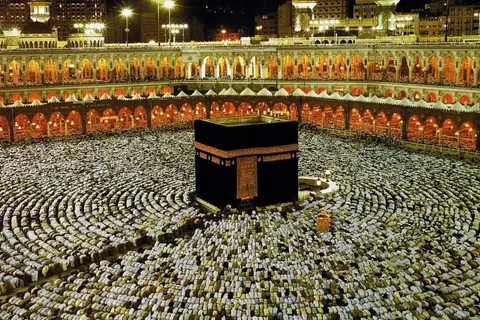Understanding the difference between hajj and umrah is essential for every Muslim, therefore, in this guide we will explore the meaning of Hajj and Umrah, the main differences, and more. Let’s get started.
What Is Hajj?
In order to really have an idea of the difference between hajj and umrah, it’s necessary to begin by knowing what Hajj is and why it’s so central to Islam.
Hajj is the major pilgrimage to Makkah, the holy city, and it’s one of the Five Pillars of Islam, meaning that it’s an obligatory act for every physically and financially capable Muslim to make at least once in a lifetime.
Hajj is not a vacation; it’s a profound act of faith that embodies unity, humility, and submission to Allah.
In the difference between hajj and umrah, timing is the most distinguished feature. Hajj is just once a year, on specified days in the Islamic month of Dhul-Hijjah—8th to 13th. Millions of Muslims gather on these sacred days to relive a series of rituals tracing back to the Prophet Ibrahim (AS) like Tawaf, Sa’i, standing at Arafat, and stoning the pillars at Mina.
The other key consideration to mention when discussing the difference between hajj and umrah is the overall magnitude of Hajj’s rituals. Hajj is so much more than a bodily pilgrimage, it’s a complete spiritual makeover.
The Prophet Muhammad ﷺ said, “Whoever performs Hajj and does not commit any obscenity or wrongdoing, he will return as free from sin as the day his mother bore him” (Bukhari & Muslim).
What Is Umrah?
To gain a better understanding of the difference between hajj and umrah, we need to learn what Umrah is and how it differs in both practice and divine significance.
Umrah is referred to as the “lesser pilgrimage” at times, but that does not speak negatively of it. It is a beautiful act of piety that, like Hajj, is performed in Makkah and consists of going to the sacred sites and performing some rituals.
Unlike Hajj, with set dates, one of the most apparent difference between hajj and umrah is that Umrah can be performed throughout the year. While it is not an obligation, it is highly recommended (Sunnah Mu’akkadah) to those Muslims who can perform it.
Many people make Umrah in Ramadan due to the added rewards, but other people do it throughout the year to spiritually recharge.
Yet another important difference between hajj and umrah lies in the number and complexity of rituals.
Umrah involves four major processes: Ihram, Tawaf (circumambulation of the Kaaba), Sa’i (running between Safa and Marwah), and shaving or trimming the hair. It may be performed within a matter of hours, and as such, it is simpler to perform and more convenient than Hajj.
But the spiritual benefit of Umrah is robust. Based on the Prophet Muhammad ﷺ, “The performance of Umrah is expiation for the sins committed between it and the previous one” (Bukhari & Muslim).
This shows that although it is not obligatory, it is greatly blessed. Understanding this makes it simpler for individuals who are willing to grow in their practice and faith to separate Umrah from Hajj.
Main Differences Between Hajj and Umrah
Now that we’ve explored each pilgrimage separately, let’s break down the difference between hajj and umrah. Although they’re both expressions of devotion that take place in Makkah, they differ remarkably in terms of obligation, timing, length, and rituals.
For easy remembrance of the variation between Hajj and Umrah, here’s a brief comparison table:
| Aspect | Hajj | Umrah |
| Obligation | Mandatory once in a lifetime for every able Muslim | Voluntary, but highly recommended (Sunnah) |
| Timing | Fixed dates (8th to 13th Dhul-Hijjah) | Can be performed any time of the year |
| Duration | Takes several days to complete | Can be completed in a few hours |
| Key Rituals | Includes Ihram, Tawaf, Sa’i, Arafat, Muzdalifah, Mina, stoning of Jamarat, sacrifice | Includes Ihram, Tawaf, Sa’i, and shaving/cutting hair only |
| Spiritual Significance | One of the Five Pillars of Islam, spiritual rebirth | An expiation of sins, and a way to earn immense reward |
| Number of Times Required | Once in a lifetime if able | No limit—can be done multiple times |
Common Misconceptions About the Difference Between Hajj and Umrah
Even among practicing Muslims, there are some misconceptions about the difference between hajj and umrah. Disposing of these myths is important for those who wish to practice Islamic teachings accurately and confidently.
1. “Umrah Can Replace Hajj”
One of the most common myths is that it is sufficient to perform Umrah, and somehow this acts as a substitute for the obligation of Hajj.
Unfortunately, in reality, it is not like that. Even though both are important, Umrah cannot be substituted with Hajj. Understanding this is the key to grasping the actual difference between hajj and umrah, Hajj is obligatory, but Umrah is voluntary but rewarding.
2. “Both Have the Same Rituals”
It is easy to think that Hajj and Umrah are nearly identical since both are going to Makkah and doing Tawaf and Sa’i. Hajj and Umrah are different in terms of the additional steps of doing Hajj, like standing at Arafat, living in Muzdalifah, and pelting the Jamarat. These activities are Hajj-specific and must be done for its success.
3. “Hajj Can Be Done Anytime Like Umrah”
But another huge misconception is about the time. Individuals do not recognize that Hajj has a specific time, whereas Umrah is accessible at any time of the year.
This refers to a huge difference between hajj and umrah in terms of flexibility and scheduling. Hajj must be executed in Dhul-Hijjah, and performing it at any other time is invalid.
4. “You Can Skip Ihram for Umrah”
Others believe that Ihram is only required for Hajj. But the reality is that both Hajj and Umrah require you to come into the state of Ihram before beginning the rituals. The difference between hajj and umrah is not that you wear Ihram, but what comes after wearing this sacred state.
5. “You Can Perform Hajj Without Studying the Rituals”
Hajj is not a physical travel itself—it requires deep spiritual preparation and good knowledge of the steps involved. Not knowing the right way can lead to mistakes. It is where obtaining the difference between hajj and umrah, and understanding each of them the correct way, is important—most especially for beginners.
Spiritual Benefits of Hajj and Umrah
Both Hajj and Umrah are of immense spiritual merit and offer unique opportunities for Muslims to be drawn closer to Allah. Recognizing the difference between hajj and umrah increases our sensitivity to these blessings.
1. The Transformative Power of Hajj
Hajj is often referred to as spiritual rebirth. In the words of the Prophet Muhammad ﷺ, “Whoever goes for Hajj and does not indulge in obscenity or evil, will come back pure from sin as his mother gave birth to him” (Bukhari & Muslim).
This is perhaps the most significant part of the difference between hajj and umrah, as Hajj rituals—especially standing at Arafat—are such wonderful opportunities for repentance, pardon, and reaffirmation of faith.
2. The Continuing Blessings of Umrah
Although Umrah is not obligatory, it is very rewarding and a purification. The Prophet ﷺ has said, “The performance of Umrah is an expiation for the sins committed between it and the previous one” (Bukhari & Muslim).
That is, performing Umrah regularly keeps the heart of a Muslim pure and free from spiritual impurities.
3. Establishing Unity and Humility
We now know the differences between Hajj and Umrah, however, both Hajj and Umrah unite Muslims from all over the world, demonstrating the unity of the Ummah. The rituals instill humility, wearing simple Ihram clothes, being equal in front of Allah, and focusing only on worship.
Continue Your Journey of Understanding
Ready to deepen your knowledge beyond the Hajj rituals day by day? Explore these helpful guides tailored for every step of your pilgrimage:
Discover the rules of ihram for men and women and enter Hajj in a state of purity.
Learn how to perform Tawaf with confidence and focus.
Understand the sacred Sa’i between Safa and Marwah in a clear, step-by-step way.
Unsure what to do in Mina during Hajj? We’ve got you covered.
Reflect on what is the Day of Arafat and why it’s the heart of Hajj.
Prepare for the important Muzdalifah night rituals every pilgrim must know.
Follow our stoning the Jamarat guide to complete this symbolic act correctly.
Learn how to do animal sacrifice in Hajj with our complete how-to.
Get Tawaf al-Ifadah explained so you don’t miss this key ritual.
Don’t forget a thing—our Hajj packing list essentials will keep you organized.
Stay safe with expert advice on staying healthy during Hajj.
Wondering what to do after Hajj? Start your next chapter spiritually strong.
If you’re new to Islam, read our Hajj guide for new Muslims—made just for you.
Set meaningful spiritual goals for Hajj to get the most out of your journey.
Find clear answers to the most common Hajj questions answered by experts.
Dive deeper into each topic and walk your Hajj journey with clarity and peace of mind.




